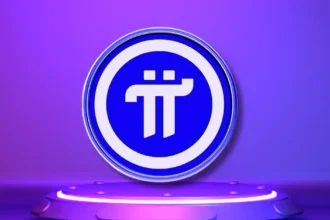In decentralized technology, few networks have garnered as much attention as Pi Network. Launched with a vision to make cryptocurrency and decentralized internet more accessible to everyday users, Pi Network is rapidly evolving into a major player, with its node infrastructure capturing significant interest from tech enthusiasts, crypto analysts, and the general public alike. The latest reports show that Pi Network has achieved a remarkable milestone: 154,387 active nodes from a total of 206,416 machines. These numbers place Pi Network at the top of node rankings, even surpassing leading cryptocurrencies like Bitcoin and Ethereum. This accomplishment not only highlights Pi’s impressive growth but also reflects its potential to drive the decentralized internet revolution and lead Web3.0 development.
Understanding the Role of Nodes in Decentralization
To appreciate the significance of Pi Network’s node growth, it’s essential to understand the role nodes play within a decentralized network. In a decentralized blockchain, nodes are individual computers that store, validate, and broadcast information across the network. Unlike centralized systems, where a single authority controls data and transactions, decentralized networks rely on a distributed web of nodes to maintain accuracy, security, and transparency.
Each node within a network serves as a safeguard against potential manipulation and unauthorized changes, as the network’s ledger is distributed across multiple locations rather than being confined to one centralized server. Nodes contribute to the network’s resilience, as they can function independently and are harder to compromise collectively. This structure forms the backbone of the decentralized internet, also known as Web3.0, where data is not controlled by a single entity but instead is shared, secured, and governed by a community.
Pi Network’s Approach to Node Growth and Community Engagement
Pi Network’s impressive success in building a vast node network is a testament to its strategic approach to community engagement. From its inception, Pi Network has been committed to making cryptocurrency accessible to users who may not have the technical expertise to participate in complex blockchain networks. Through an intuitive mobile mining experience and an inclusive environment, Pi has cultivated a community of users who actively contribute to its growth.
One of the ways Pi has achieved this is by lowering the barrier to entry for node participation. Unlike other cryptocurrencies that require specialized hardware or significant technical knowledge to operate a node, Pi Network has made it possible for users to run nodes from their mobile devices and regular computers. This ease of access has attracted a broad range of participants and has fueled the network’s rapid growth.
The community-oriented approach has helped Pi Network amass a global base of dedicated users. With more than 200,000 machines registered as nodes, Pi has established one of the most extensive and engaged networks in the cryptocurrency world. This massive support base is not only the foundation for Pi’s growth but also a vital asset as it prepares to transition to its Mainnet phase, where decentralized transactions will occur on Pi’s independent blockchain.
Pi Network’s Competitive Edge: Surpassing Bitcoin and Ethereum in Node Count
Surpassing renowned cryptocurrencies like Bitcoin and Ethereum in active node count is a noteworthy accomplishment for Pi Network. Bitcoin, which has the largest market capitalization, operates on a well-established blockchain with thousands of nodes worldwide. However, running a Bitcoin node requires substantial resources and technical skills, limiting the number of active nodes. Similarly, Ethereum has also amassed a large network of nodes, especially with the recent migration to Ethereum 2.0, but it still does not match Pi Network’s current node activity.
Pi Network’s ability to foster such an expansive node presence demonstrates its unique position in the decentralized landscape. Pi’s approach of prioritizing accessibility and simplicity allows everyday users to participate in the blockchain network, something Bitcoin and Ethereum have struggled to offer to the same degree. This focus on accessibility has resulted in Pi Network’s nodes spanning across a diverse demographic, bringing decentralization closer to mainstream adoption.
The Upcoming Mainnet and Its Potential Impact
With the Mainnet phase on the horizon, Pi Network is set to undergo a transformative change that could solidify its place as a central force in the decentralized internet. Currently, Pi operates in an enclosed ecosystem where users can mine and transact Pi tokens in a test environment. However, with the launch of the Mainnet, Pi Network will transition into a fully operational blockchain, enabling peer-to-peer transactions, decentralized applications (dApps), and a range of blockchain-based services.
This shift to Mainnet is expected to drive Pi Network’s node count even higher. As more users recognize the potential of Pi as a decentralized currency and internet platform, the number of nodes could expand into the millions. An extensive node network will provide Pi Network with the infrastructure required to support a truly decentralized and scalable blockchain. It will also pave the way for Pi to play a prominent role in Web3.0 development, where decentralization is anticipated to redefine the future of the internet.
Pi Network and the Vision for Web3.0
The concept of Web3.0, often referred to as the decentralized web, envisions an internet where control is in the hands of the users rather than a few powerful corporations. Web3.0 seeks to create an online environment that is open, secure, and inclusive, with data and transactions handled through decentralized networks. In this context, Pi Network’s robust node presence positions it as a significant contributor to the decentralized web, and potentially one of its pioneers.
Pi’s node infrastructure ensures that data and transaction verification are distributed across a wide network of users, eliminating the need for central authorities and enhancing the security of the platform. Moreover, Pi Network’s commitment to accessibility aligns with the principles of Web3.0, where inclusivity and user empowerment are core values. As Web3.0 continues to gain momentum, Pi Network’s scalable node network could enable it to play a crucial role in advancing the decentralized internet.
The Path Forward: Challenges and Opportunities for Pi Network
While Pi Network’s growth is undeniably impressive, the project faces challenges as it transitions to the Mainnet phase. One of the primary concerns is scalability; as the number of nodes increases, Pi Network will need to ensure that its infrastructure can handle the increased load while maintaining security and efficiency. Moreover, Pi Network will need to address potential regulatory hurdles as decentralized systems gain more attention from governments and regulatory bodies.
Another challenge lies in driving adoption beyond the current community. For Pi Network to become a central player in Web3.0, it will need to attract developers who can build decentralized applications on its blockchain, fostering a vibrant ecosystem similar to those seen on Ethereum and other blockchain platforms. To accomplish this, Pi may need to implement developer-friendly tools and resources that encourage innovation within its ecosystem.
On the other hand, Pi Network has numerous opportunities as it progresses. The growing interest in Web3.0 and decentralized finance (DeFi) presents Pi with an ideal environment to expand its influence and attract a wider audience. With its community-centric approach and accessibility, Pi is well-positioned to introduce new users to decentralized technologies, driving broader adoption of Web3.0 principles. Continue Reading
Conclusion: Pi Network’s Role in the Future of Decentralization
Pi Network’s remarkable growth in active nodes signifies more than just a technical milestone; it represents the project’s potential to reshape the future of the internet. By prioritizing accessibility and community engagement, Pi Network has created a decentralized platform that appeals to a wide demographic, setting it apart from traditional cryptocurrencies and blockchain networks. As Pi Network prepares for its Mainnet launch, its extensive node network could enable it to play a transformative role in the Web3.0 revolution.
The decentralized internet promises a more secure, transparent, and inclusive digital landscape, and Pi Network’s strong foundation in node infrastructure makes it a promising contributor to this vision. With its momentum and community support, Pi Network is not only positioned to redefine how individuals interact with blockchain technology but also to lead the path toward a decentralized internet that empowers users across the globe. In a world increasingly driven by data and connectivity, Pi Network’s dedication to decentralization may well shape the future of online interactions and digital ownership.
















